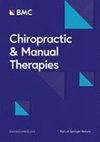手法机制:对有关人工高速、低振幅脊柱手法引起的直接解剖结构或位置变化的文献进行系统回顾
IF 2
4区 医学
Q2 REHABILITATION
引用次数: 0
摘要
脊柱手法(SM)被认为能改变解剖结构或位置,而这些改变可能是临床改善的原因。本系统性综述旨在评估和综合同行评议文献中有关脊柱手法引起解剖结构变化的现有证据。该综述已在 PROSPERO(CRD42022304971)注册,报告遵循 PRISMA 声明的标准。我们检索了 Medline、Embase、CINAHL、AMED、Cochrane 图书馆的所有数据库、PEDro 和《脊骨神经医学文献索引》,检索期从开始至 2022 年 3 月 11 日,更新至 2023 年 6 月 6 日。搜索关键词包括手法、调整、整脊、整骨、脊柱和脊柱相关结构。无论研究设计如何,我们都纳入了比较有无手法治疗结果的主要研究。手法是指用手对脊柱或直接相关的关节进行高速度、低振幅的推压。纳入的研究客观地测量了解剖结构或位置的潜在变化。除了一份简短、定制的偏倚风险(RoB)项目清单外,我们还制定了一份新的方法学质量项目清单。我们将质量项目和偏倚风险项目结合起来使用,以确定一篇文章是否可信。对于随机对照试验和交叉研究,我们寻求SM组和对照组之间结果的差异;对于其他研究设计,我们寻求SM前后结果的差异。我们以叙述的形式报告了是否有变化。搜索共检索到 19,572 篇文章,其中 20 篇被纳入审查范围。研究主题包括椎体位置(n = 3)、关节面间隙(n = 5)、脊柱僵硬(n = 3)、静息肌肉厚度(n = 6)、椎间盘压力(n = 1)、肌筋膜滞后(n = 1)以及已受损动脉的进一步损伤(n = 1)。八篇文章被认为是可信的。可信的文章表明,腰椎面关节间隙增大,脊柱僵硬度降低,但静息肌肉厚度没有变化。我们发现有关这一主题的研究很少。不过,有两个领域很有希望在未来进行研究:面关节间隙和脊柱僵硬度。应制定研究战略,为高质量的研究中心提供资金。本文章由计算机程序翻译,如有差异,请以英文原文为准。
Mechanisms of manipulation: a systematic review of the literature on immediate anatomical structural or positional changes in response to manually delivered high-velocity, low-amplitude spinal manipulation
Spinal manipulation (SM) has been claimed to change anatomy, either in structure or position, and that these changes may be the cause of clinical improvements. The aim of this systematic review was to evaluate and synthesise the peer-reviewed literature on the current evidence of anatomical changes in response to SM. The review was registered with PROSPERO (CRD42022304971) and reporting was guided by the standards of the PRISMA Statement. We searched Medline, Embase, CINAHL, AMED, Cochrane Library all databases, PEDro, and the Index to Chiropractic Literature from inception to 11 March 2022 and updated on 06 June 2023. Search terms included manipulation, adjustment, chiropractic, osteopathy, spine and spine-related structures. We included primary research studies that compared outcomes with and without SM regardless of study design. Manipulation was defined as high-velocity, low-amplitude thrust delivered by hand to the spine or directly related joints. Included studies objectively measured a potential change in an anatomical structure or in position. We developed a novel list of methodological quality items in addition to a short, customized list of risk of bias (RoB) items. We used quality and RoB items together to determine whether an article was credible or not credible. We sought differences in outcomes between SM and control groups for randomised controlled trials and crossover studies, and between pre- and post-SM outcomes for other study designs. We reported, in narrative form, whether there was a change or not. The search retrieved 19,572 articles and 20 of those were included for review. Study topics included vertebral position (n = 3) facet joint space (n = 5), spinal stiffness (n = 3), resting muscle thickness (n = 6), intervertebral disc pressure (n = 1), myofascial hysteresis (n = 1), and further damage to already damaged arteries (n = 1). Eight articles were considered credible. The credible articles indicated that lumbar facet joint space increased and spinal stiffness decreased but that the resting muscle thickness did not change. We found few studies on this topic. However, there are two promising areas for future study: facet joint space and spinal stiffness. A research strategy should be developed with funding for high quality research centres.
求助全文
通过发布文献求助,成功后即可免费获取论文全文。
去求助
来源期刊

Chiropractic & Manual Therapies
Medicine-Complementary and Alternative Medicine
CiteScore
3.20
自引率
15.80%
发文量
48
审稿时长
20 weeks
期刊介绍:
Chiropractic & Manual Therapies publishes manuscripts on all aspects of evidence-based information that is clinically relevant to chiropractors, manual therapists and related health care professionals.
Chiropractic & Manual Therapies is an open access journal that aims to provide chiropractors, manual therapists and related health professionals with clinically relevant, evidence-based information. Chiropractic and other manual therapies share a relatively broad diagnostic practice and treatment scope, emphasizing the structure and function of the body''s musculoskeletal framework (especially the spine). The practices of chiropractic and manual therapies are closely associated with treatments including manipulation, which is a key intervention. The range of services provided can also include massage, mobilisation, physical therapies, dry needling, lifestyle and dietary counselling, plus a variety of other associated therapeutic and rehabilitation approaches.
Chiropractic & Manual Therapies continues to serve as a critical resource in this field, and as an open access publication, is more readily available to practitioners, researchers and clinicians worldwide.
 求助内容:
求助内容: 应助结果提醒方式:
应助结果提醒方式:


